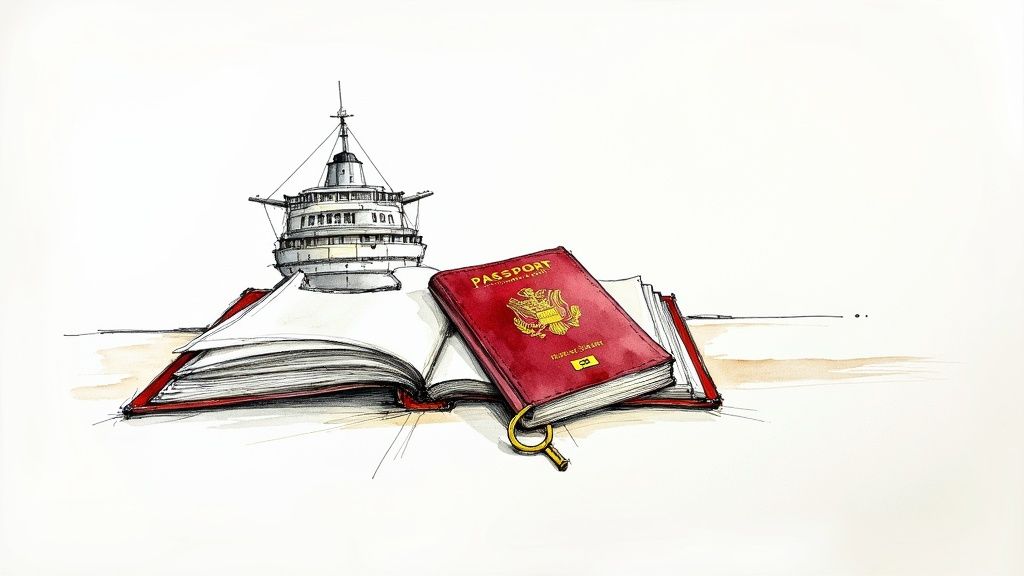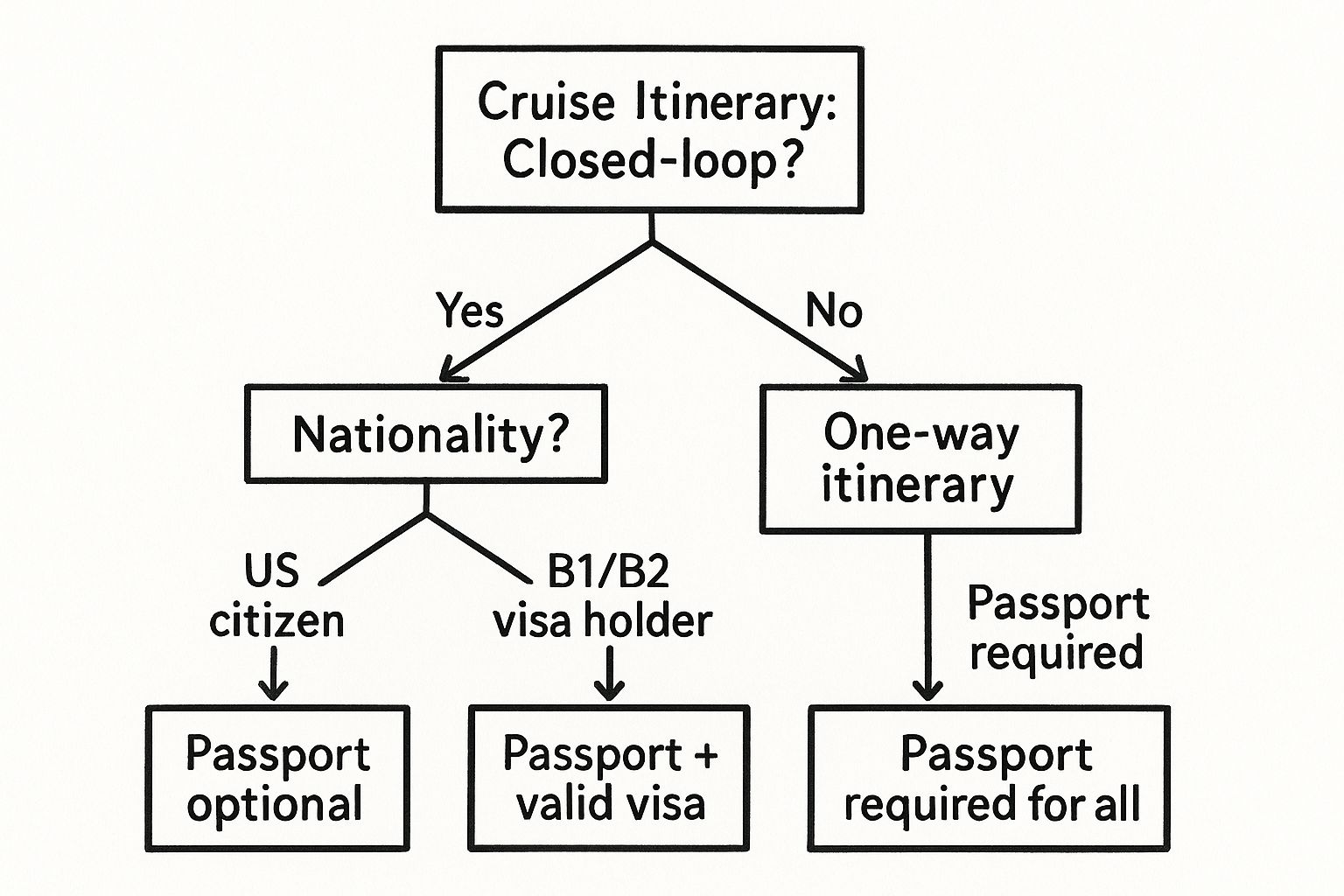If you're an international visitor planning a cruise from the U.S., you've probably heard conflicting advice about what documents you need. Let's clear things up right away: Yes, a valid passport from your home country is almost always required.
You might see information online about U.S. citizens using other documents for "closed-loop" cruises, but those exceptions don't apply to non-U.S. citizens. For visitors holding a B-1/B-2 visa, the rules are much stricter.
Your Guide to Cruise Travel Documents

Whether you're visiting from Mexico, Colombia, Brazil, or another country, navigating the documentation for a U.S.-based cruise can feel overwhelming. A lot of the advice out there is aimed at American citizens, who have entirely different rules for entering and exiting their own country.
As an international traveler, your passport is your golden ticket. It's not just a good idea—it's the key to getting on the ship and, more importantly, being allowed back into the United States when your cruise is over.
Think of your passport as your master key for international travel. It’s what gets you into foreign ports and is the only document that guarantees U.S. Customs and Border Protection will let you back in when the ship returns.
Without a valid passport, you won’t even get past the check-in counter. Cruise lines are incredibly strict about this because they face steep fines for carrying passengers without the right paperwork.
This guide will walk you through exactly what's needed so you can plan your vacation with confidence. While some U.S. citizens can sometimes use a certified copy of a birth certificate for a passport exemption, this is never an option for international travelers. For you, the passport is non-negotiable.
Here’s a quick-glance table to help you remember the essentials based on your travel plans.
Cruise Document Checklist for International Travelers
| Cruise Type | Passport Rule for Non-U.S. Citizens | Key U.S. Visa Consideration |
|---|---|---|
| Closed-Loop Cruise | Passport Required. The exception is for U.S. citizens only. | Your visa must be valid for multiple entries. |
| One-Way International Cruise | Passport Required. Also need a visa for the destination country. | Your visa must allow for U.S. departure to a foreign country. |
This table serves as a simple reminder: no matter which cruise you choose, your passport is the one document you absolutely must have with you.
Closed-Loop vs. One-Way Cruise Itineraries
When it comes to figuring out if you need a passport for your cruise, one thing matters more than anything else: your ship's itinerary. The route your cruise takes sets the rules for every single person on board. The first step is getting a handle on the difference between a "closed-loop" and a "one-way" sailing.
Think of a closed-loop cruise as a simple round trip. It starts and ends in the exact same U.S. port. A classic example is a cruise that departs from Miami, makes a stop in the Bahamas, and then sails right back to Miami.
This is where things can get a little confusing for some travelers. U.S. citizens might be able to get by with other documents on these specific routes. However, this exception does not apply to international visitors holding B-1/B-2 visas from countries like Mexico, Colombia, or Brazil. You absolutely still need your valid passport and U.S. visa to prove you can legally re-enter the country when the fun is over.
The Rules for One-Way International Cruises
A one-way cruise is a completely different story. These voyages begin in one port and finish in another, often in an entirely different country. Picture a cruise sailing from New York City and ending in London, or one that travels from Los Angeles up to Vancouver.
For these kinds of trips, the rules are crystal clear and much simpler. Every passenger, no matter their nationality, must have a valid passport. It's not optional. You're officially entering a new country when you get off the ship for the final time, so there are no exceptions.
This decision tree helps break down how your itinerary and nationality determine what documents you’ll need.

The main point to remember is this: while U.S. citizens might have some wiggle room on closed-loop sailings, for international travelers, the answer is always the same. A valid passport is a must-have for your cruise.
Why Your Passport Is Your Most Important Travel Companion

It’s one thing to have the bare minimum documents to get on the ship, but bringing your passport is always the smartest move for any international cruise. Why? Because things don't always go according to plan.
Picture this: you're having an amazing time on a shore excursion in Jamaica when a flat tire on your tour bus makes you miss the ship. Or, even worse, a sudden medical emergency in a Mexican port means you have to fly home immediately.
If you don't have your passport with you, you're stuck. Seriously stranded.
Your Key To Handling The Unexpected
In those nightmare scenarios, a passport isn't just an ID—it's your lifeline. Without it, you're facing a logistical mess:
- No Flights Home: You simply cannot board an international flight back to the United States. Airlines are strict and legally required to check your passport before you can fly.
- Consulate Headaches: Getting help from your home country's consulate becomes a frustrating, time-sucking ordeal. Trying to prove your identity and get emergency travel documents can take days, delaying your trip home even further.
A passport is your ultimate safety net on any cruise. It’s not just about getting on the ship; it’s about ensuring you have the freedom and security to handle any unexpected detours your journey might take.
This one little book guarantees you can navigate a bad situation with far less stress. For any non-U.S. citizens, it's the only document that universally proves your identity and your right to travel. The peace of mind alone is worth it.
Given its importance, knowing the requirements and fees is a crucial part of planning your trip. You can learn more about the cost of a passport to get a better handle on your budget. Honestly, having it with you is the best travel insurance policy you can have.
Navigating Foreign Port and Country Requirements
Every time your cruise ship pulls into a new port of call, you're essentially crossing an international border. Each country has its own set of laws for who can enter and what documents they need, and cruise lines are legally required to follow these rules to the letter.
This is a really important detail to grasp, especially for international itineraries. Popular cruise destinations like Panama, Colombia, and most countries in Europe and Asia have an iron-clad rule: if you arrive by sea, you must present a valid passport. No other document will do.
So, when a cruise line employee asks to see your passport, they aren't just following company policy. They're complying with international law.
Understanding The Six-Month Validity Rule
Now, it’s not just about having a passport; the expiration date is just as critical. Many countries follow what's known as the “six-month validity rule,” a standard that trips up countless travelers and can get you denied boarding before you even see the ship.
The rule is simple: your passport must be valid for at least six months after you are scheduled to return home. So, if your cruise wraps up on June 1, 2025, your passport needs to have an expiration date of December 1, 2025, or later.
Why the extra six months? Think of it as a buffer. It’s a safeguard to ensure that if you get stuck overseas due to an emergency or unexpected delay, your passport remains a valid travel document for your entire stay and your trip back.
This requirement is not something you can talk your way out of. As you can see on the Norwegian Cruise Line preparation page, travel document rules depend entirely on the itinerary. If a single port on your trip requires a passport with six months of validity, you must have one, or you won't be cruising.
The best habit you can get into is checking your passport's expiration date long before you even start looking at cruise brochures.
Why Cruise Lines Are So Strict About Your Passport

Ever wondered why cruise lines and border officials are such sticklers for documentation? It’s not just red tape. This strictness is a direct result of the cruise industry's massive global explosion in popularity.
Think about it: millions of people from hundreds of different countries are hopping on and off ships every single day. To keep things running smoothly—and safely—international ports need a standardized, secure way to process this incredible volume of travelers.
A passport is the universal language of international travel. It allows customs and immigration officials in any country to quickly verify your identity and legal status, which is essential for managing the flow of millions of travelers.
This system is built for security and efficiency. It ensures that every single passenger, whether they're from Mexico, Colombia, or Canada, can be processed using the same reliable procedure.
Growth Makes Passports Non-Negotiable
And the industry isn't slowing down. As more and more people discover cruising, the numbers just keep climbing. We're looking at a projected 37.7 million passengers hitting the high seas in 2025 worldwide.
This incredible growth reinforces why passports are so critical for international itineraries. You can learn more about the trends shaping cruise travel on ACG.AAA.com.
At the end of the day, the strict passport rules you encounter aren't just coming from the cruise line. They're a vital part of a global security system designed to keep international travel safe and efficient for everyone, especially as more of us than ever choose to explore the world by sea.
Cruise Travel Questions for Visa Holders
Let's wrap up by tackling some of the most common questions we hear from international travelers and B-1/B-2 visa holders. Getting these details right is crucial for a stress-free trip, so let's clear up any confusion.
Can I Use My National ID Card on a Closed-Loop Cruise?
For non-U.S. citizens, this is a definite no. You might see U.S. citizens using other documents on certain cruises, but those rules simply don't apply to international visitors.
When your ship returns, U.S. Customs and Border Protection will require your valid passport and your U.S. visa to let you back in. Trying to re-enter with just a national ID is a huge gamble that could end with you being denied entry back into the United States.
Does My B-1/B-2 Visa Need to Be Valid for the Whole Cruise?
Yes, without a doubt. Your B-1/B-2 visa absolutely must be valid on the day your cruise ends and you re-enter the U.S. An expired visa, even by one day, will cause serious problems with immigration officials.
Before you even pack your bags, check your visa's expiration date and make sure it's well after your cruise's return date. It’s a small step that prevents a massive headache. To feel completely confident, it’s smart to have all your documents ready. You can use our B-2 visa documents checklist to make sure you haven't missed anything.
Key Takeaway: Think of your valid passport and U.S. visa as the two essential keys for your cruise. You need both to lock up your travel plans securely—they must be valid for your entire trip, from departure to return.
What if a Port of Call Requires Its Own Visa?
This is a big one: you are 100% responsible for researching and obtaining any visas required by the countries on your itinerary. The cruise line will not handle this for you.
Before you book, look up the entry requirements for every single port of call based on your citizenship. For instance, if you are a citizen of a country that requires a visa for Jamaica or the Bahamas, you must secure it in advance. If you don't have it, you could be denied boarding altogether or forced to stay on the ship while everyone else explores the port.
Navigating visa appointments can be a stressful waiting game. Vast Fisa takes the pressure off by automatically searching for earlier U.S. visa appointment slots for you. Stop refreshing the calendar and let our service find a better time. Learn more and sign up at https://www.vastfisa.com.
